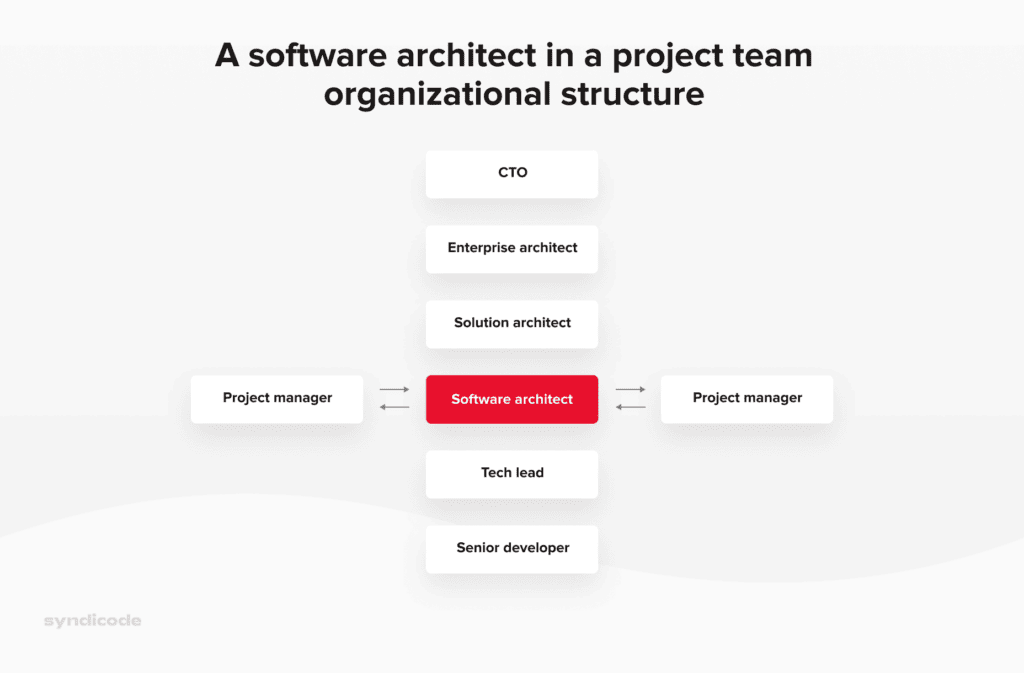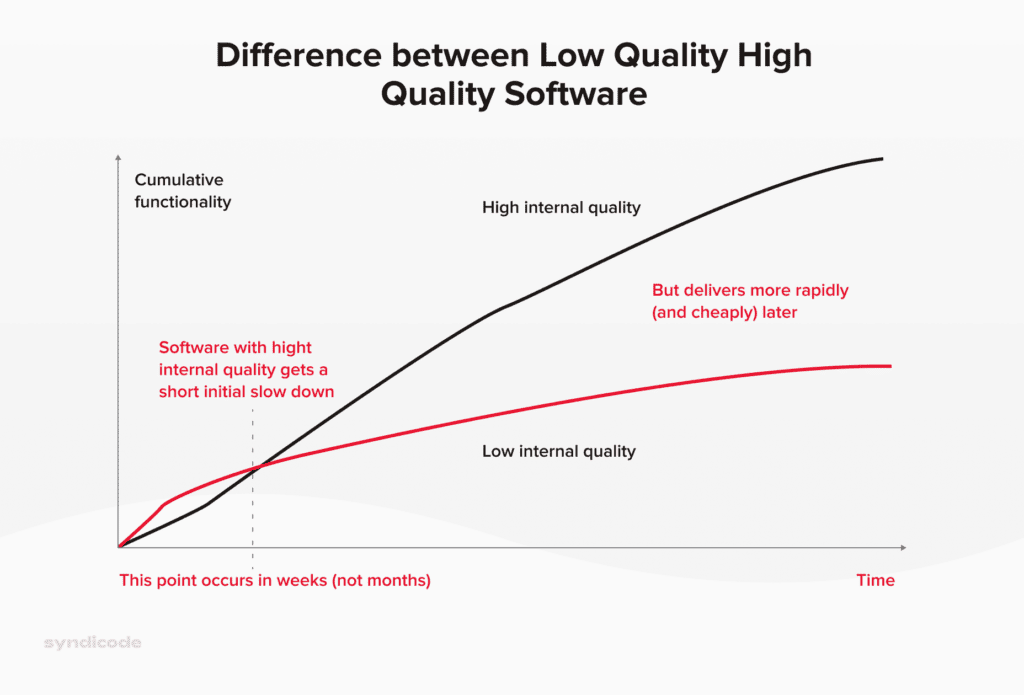A software architect creates the concepts for software and helps turn those concepts into plans, just like an architect who designs buildings. But while building architects are not typically concerned with how their ideas are implemented, a software architect is engaged throughout all stages of the software development process, making high-level decisions regarding the tools, coding standards, or platforms to be used.
Hence, the software architect requirements involve various technical and personal skills. In this post, we will feature a definition of a software architect and list their responsibilities and required competencies.
You will also learn the benefits of having a software architect engaged in every step of the software development lifecycle (SDLC). Eventually, you will be able to make an informed decision on whether you should hire an architect for your project. And if so, you will know what to put in your software architect job description.
What is a software architect?
In most general terms, a software architect is responsible for planning and organizing a software system. These experts dictate software coding standards and choose optimal tools for custom software development. They also help translate ideas into technical tasks and correctly distribute them to the development team.
Here is more specific information on what a software architect may do in a project:
- Interact with clients, product managers, and developers to envision, model, and design the software solution. A software architect advocates clarity and transparency between the client and the team.
- Perform regular code reviews to ensure the design quality and avoid overly complicated structures. These tasks usually involve hands-on work on prototype development, code contributions, or technological assessment.
- Collaborate and mentor. A software architect’s skills should enable them to help the development team and enhance their knowledge.
The position of a software architect requires a profound knowledge of software functionality, performance, viability, scalability, comprehensibility, security, and technological constraints. At the same time, the exact software architect’s roles and responsibilities will depend on the project’s needs and size. So, it’s crucial to understand how the role of an architect differs from that of other IT specialists.
Software architect roles and responsibilities in the SDLC
A software architect works closely with other project team members to deliver a successful product. For once, they write code similarly to a developer’s but focus on standards reinforcement rather than building software parts.
Thus, an architect might write high-level pseudocode, a proof of concept, or a third-party API to help transfer business requirements to functional ones faster. Meanwhile, a developer focuses on transferring functional requirements to code.
Next, both a software architect and a tech lead drive improvements to the development process. Yet, while the latter focuses on tactics, the architect considers the overall product strategy. However, in smaller companies, a single person may combine both roles.
The product manager’s role is often confused with that of a software architect. The main difference is that the manager researches market opportunities, and the architect analyzes current technical possibilities.
Finally, a software architect and a project manager oversee the successful product delivery. But as the former is responsible for the technical risks and code quality, the latter undertakes tasks associated with scope, budget, and time frames.

Besides, a software architect’s roles and responsibilities will differ depending on the project’s development cycle. For Agile development, the typical duties will roughly look as follows:
Pre-Development stage
In the initial stage of software development, the architect will help identify the client’s business problems and necessary resources. A software architect will study requirements and consider constraints. An architect’s central question is whether the idea is feasible within the given budget and timeframes.
The primary responsibilities of a software architect at this stage include:
- Gathering early functional and non-functional requirements;
- Selecting a technology stack;
- Estimating development time;
- Delivering a high-level architectural design.
Prototyping
With the proposal approved, the software architect decides how to build the solution. They consider all potential technical constraints and risks and map out how to implement the idea. Next, the architect creates an architectural prototype to ensure the software development team can actually build the solution. The prototype proves the product will be stable, feasible, and realistic.
A software architect is also the one who makes high-level design choices.
The software architect’s primary responsibilities are:
- Address possible risks and constraints;
- Provide detailed architectural blueprints;
- Prove the solution’s viability.
Development
Once the development process starts, the software architect will continue designing components and features. They set quality standards and ensure code compliance with predefined requirements. The architect will also participate in technical task writing if there is no dedicated team lead on the project. In case of changes, the software architect will ensure they don’t negatively affect the expected product characteristics.
Major responsibilities include:
- Setting quality standards;
- Change management;
- Development team mentoring;
- Further architecture specification;
Quality assurance
A software architect helps select QA tools and participates in deployment. They also make critical decisions on deployment methods, environments, and infrastructures, and code freezes. Moreover, the architect can initiate changes in the project structure or infrastructure. At the same time, they ensure those alterations do not affect the project budget and timeline.
Main responsibilities:
- Testing and deployment supervision;
- Releases management.
Post-development
As the product is live, the engineering team stays with the client for maintenance and minor fixes. The task of a software architect is to ensure that the requirements set by the client have been met in full. The architect also ensures regular check-ups and all prompt addressing of the detected issues.
Sometimes a client may want to make changes to the completed project. In this case, the development process starts over from phase one.
Software architect’s responsibilities:
- Ensuring the product is functional;
- Communication with the client.
Types of software architects
Since a software architect’s roles and responsibilities encompass many things, larger companies introduce new positions depending on the tasks.
Thus, a data and information architect works with data integration processes in a company, business intelligence systems, databases, and file systems.
Enterprise software architects supervise the organization’s IT networks and services. These experts ensure that the system architecture aligns with the company’s strategy and report directly to the Chief Information Officer (CIO) or the Chief Technology Officer (CTO).
A solution architect creates a general context of the developed solution and coordinates the project teams toward the goal. This person focuses on solving specific client needs and knows project management, business analysis, and systems architecture.
A technical architect focuses on a particular project supervising all aspects of development, maintenance, and evolution.
So, you should hire a specific type of software architect, depending on the project you have.
| Architect type | Main task | System interactions | Communication |
|---|---|---|---|
| Data architect | Make sense of data | Detailed | Data management team |
| Enterprise architect | Identify a problem | Abstract | Across organization |
| Solution architect | Resolve the problem | Detailed | Multiple teams |
| Technical architect | Build a product | Detailed | Single project |
Hire a dedicated software architect today
At Syndicode, you will find help for your project at any step of development.
Contact usSoftware architect’s main skills
A software architect’s job requires good technical knowledge and skills to manage people and projects. Since their work scope is so broad, there isn’t a one-size-fits-all list of requirements you should put in your software architect job description.
However, some universal skills will come in handy in most situations.
Hard skills
Extensive technical knowledge
A software architect needs to know the most popular programming languages and frameworks (or those used in your organization). They also have to understand the pros and cons of different software patterns to make the best decisions based on requirements, capabilities, and resources.
Coding skills
A software architect must deeply understand the software-building process to lead a team of developers. They should be able to clearly communicate tasks and write units to be reused for consistency. They also have to be able to assess code quality.
Knowledge of cloud technologies
Cloud services offer many ready-to-use solutions that help save time. One of the main software architect job requirements is the ability to choose an appropriate tool and determine when to use it.
Domain knowledge
Understanding the specifics of your business domain will help a software architect choose the most appropriate approaches to solve your problems effectively. This skill will also enable the architect to speak the same language as the C-suite.
Soft skills
Leadership
Since software architects mentor technical teams and promote quality standards and the right product vision, they should be able to win authority and respect.
Communication
An architect communicates with stakeholders, business analysts, and engineers, explaining the benefits of employing certain technologies or applying a specific pattern. They should be able to explain complex matters in simple terms.
Problem-solving
A software architect manages the system design and should be able to identify risks timely. They should also apply their knowledge, expertise, and experience to find the best solution.
Organization
A successful software product does a lot with a minimum of resources. A software architect should know how to prioritize tasks and organize their team for efficient work.
Time-management
Software architects participate in meetings with clients, collaborate with teams, and have discussions with upper-level management. To handle a busy schedule, they should be well-organized.
Creative thinking
An architect leads teams toward the goal through obstacles. They must think creatively to come up with alternatives and solve problems quickly.
Think your problem has no solution?
Software architects at Syndicode will help your team build the right mindset and never get this kind of issue.
Book a callDo you need to have your own software architect?
You have probably decided by now, but let’s go through the questions you should ask yourself before hiring a software architect:
- What industry does your business belong to?
Many technological problems already have a solution. Maybe your business needs an exemplary implementation rather than a creative thought. - What is the size of your organization?
Startups and small businesses usually require employees to wear many hats and are not ready for a niche specialist. - What is the expected output?
In other words: what is the role of the software architect in your project? You don’t need a high-level system specialist to create a simple web or mobile application. - Do you already have a development team, or are you building a team?
For an in-house team that’s big enough, it might be reasonable to hire an architect rather than outsource or outstaff.
If you choose to entrust your project to a dedicated development team or an agency, it’s easy to request software architect consulting from the same company. Moreover, this option comes with a list of benefits:
- You can select an expert from a pool of experienced professionals who have proved their excellent knowledge in your domain;
- It’s cost-efficient since you can hire an architect to tackle a particular aspect, not drive your project from start to finish;
- You will save time otherwise spent on hiring, interviewing, and training candidates;
- If an architect works in the same company as your technical team, they will have no communication issues.
Advantages of hiring a software architect
Every software project starts with a big goal in mind. It ensures that no one will spend a fortune on something that doesn’t satisfy their demands. Hence, there is a need for a professional who sees the bigger picture and can guide the development process in the right direction.
So, if you want a guarantee that your product will be scalable, efficient, productive, and within the budget, a software architect will provide just that. Other things you will benefit from are the following:
Unique user experience
A software architect offers custom code design, making your product non-duplicable and reserved exclusively for your modifications. If the project requires creating a tool for internal usage, your clients can advance in a unique way that your competitors can’t replicate.
Endless software scalability
An architect will help you incorporate the features and codes you want in a way that aligns with your business strategy. Thus, the software will have the necessary tools if your growth plans involve adding new teams. Alternatively, it will provide a solid base for adding new features without rebuilding anything.
Increased software quality
Having a product designed to assist in your day-to-day operations, you won’t experience gaps in functionality as you would with pre-made solutions. A software architect will pick the best frameworks and libraries for your needs.
Cost savings
Despite the initial costs, your company will enjoy overall savings since a software architect eliminates the need for future reworks or major upgrades. You can be positive that your solution will be solid support for your business throughout the foreseeable future.
Better recognition
A software architect will translate your vision into a product and mentor your employees. You will be able to distinguish your business by visual appearance and how things are accomplished in your company.

Bottom line: Should you hire a software architect?
A software architect’s roles and responsibilities involve taking your requirements and figuring out how to embody them in software for long-lasting impact. They work at a high level but can also go as deep as a single code line if necessary for good architecture. And if you’re careful in your choice, your company will get an opportunity to scale and pivot, minimize maintenance and operational costs, and bring revenue.
At Syndicode, you can get consulting services on software architecture from seasoned experts in custom development. We set strict skill requirements for candidates, such as being able to handle creating a system from scratch, making complex things sound simple, and having a problem-solving mindset.
Frequently asked questions
-
What do Software Architects do?
The roles and responsibilities of an architect in software development are numerous. They bridge the communication between clients and development teams to guarantee that client needs are met correctly. This person also participates in the identification of problems in current IT systems and discovers effective solutions. Further, they create strategic plans, coach, and lead teams toward a common objective. Finally, software architects select tools for implementation and establish guidelines to ensure teamwork is unified and outcomes are consistent.
-
What is the difference between software architect vs. engineer?
Software architects’ roles and responsibilities handle planning software solutions and most stages of the development process. They collect and structure requirements, engage in code reviews, design sections of the project and how they interact, and select the best software patterns, among other tasks. A software engineer creates software. They use engineering principles and programming language and follow guidelines and requirements from clients or a software architect. Typically, a software engineer’s tasks include writing and testing code, introducing new features, and enhancing software for better performance and speed.
-
How long does it take to become a software architect?
The journey to becoming a software architect often starts from roles such as a developer, lead software engineer, or IT manager. If you’re in one of these positions, you’re likely already familiar with what a software architect is, how to be a software architect, knowledgeable in various programming languages, and understand product security, quality, and extensibility guidelines. With this foundation, you could become a software architect within a few years. Your next step should be to research the specific software architect requirements for positions in your area of interest. Look at the skills and knowledge you need to acquire. This will likely include exploring more technological frameworks and expanding your technical expertise. Deepen your understanding of the role of software architecture by reading relevant literature. Enrolling in architecture courses and obtaining certifications can make you more appealing to employers. A great idea could be finding a mentor to accelerate your journey by providing insights into the profession. Additionally, since the role involves teamwork, improving your communication and management skills is crucial.
-
What is the salary of a software architect?
Software architects are among the top earners in the IT field. In the United States, they earn an average salary of about $139,000 per year, with entry-level positions starting around $109,000 annually. In Western Europe, salaries for software architects vary from approximately 18,000 EUR to 65,000 EUR per year. Meanwhile, in Eastern Europe, they earn between 10,000 EUR and 28,000 EUR annually. These figures reflect what software architects do in the specific project, including software architect’s roles and responsibilities. Despite these regional salary differences, the skill levels of software architects in the US and Europe are comparable. This means you can confidently hire offshore, knowing the quality of expertise is consistent.
